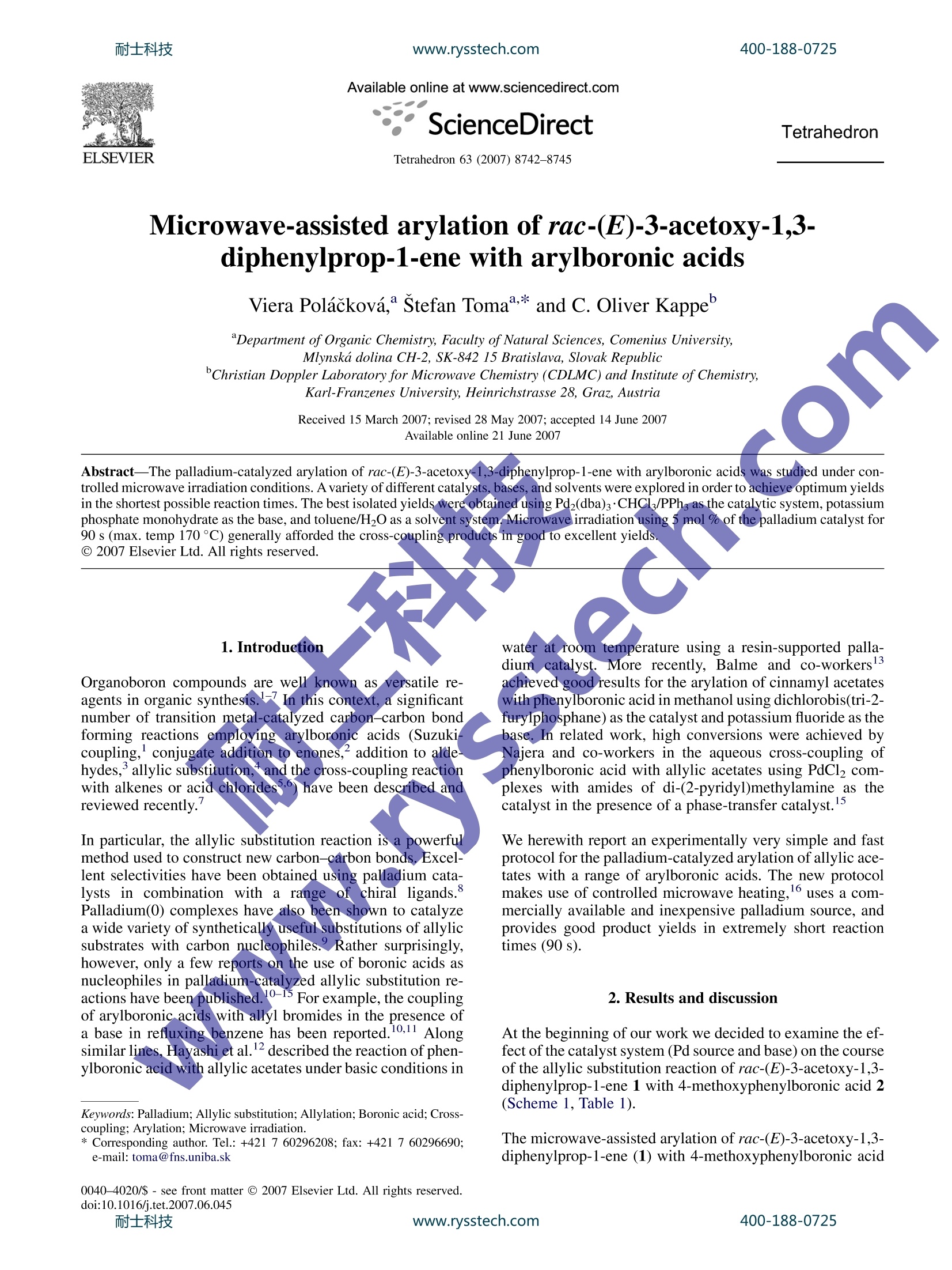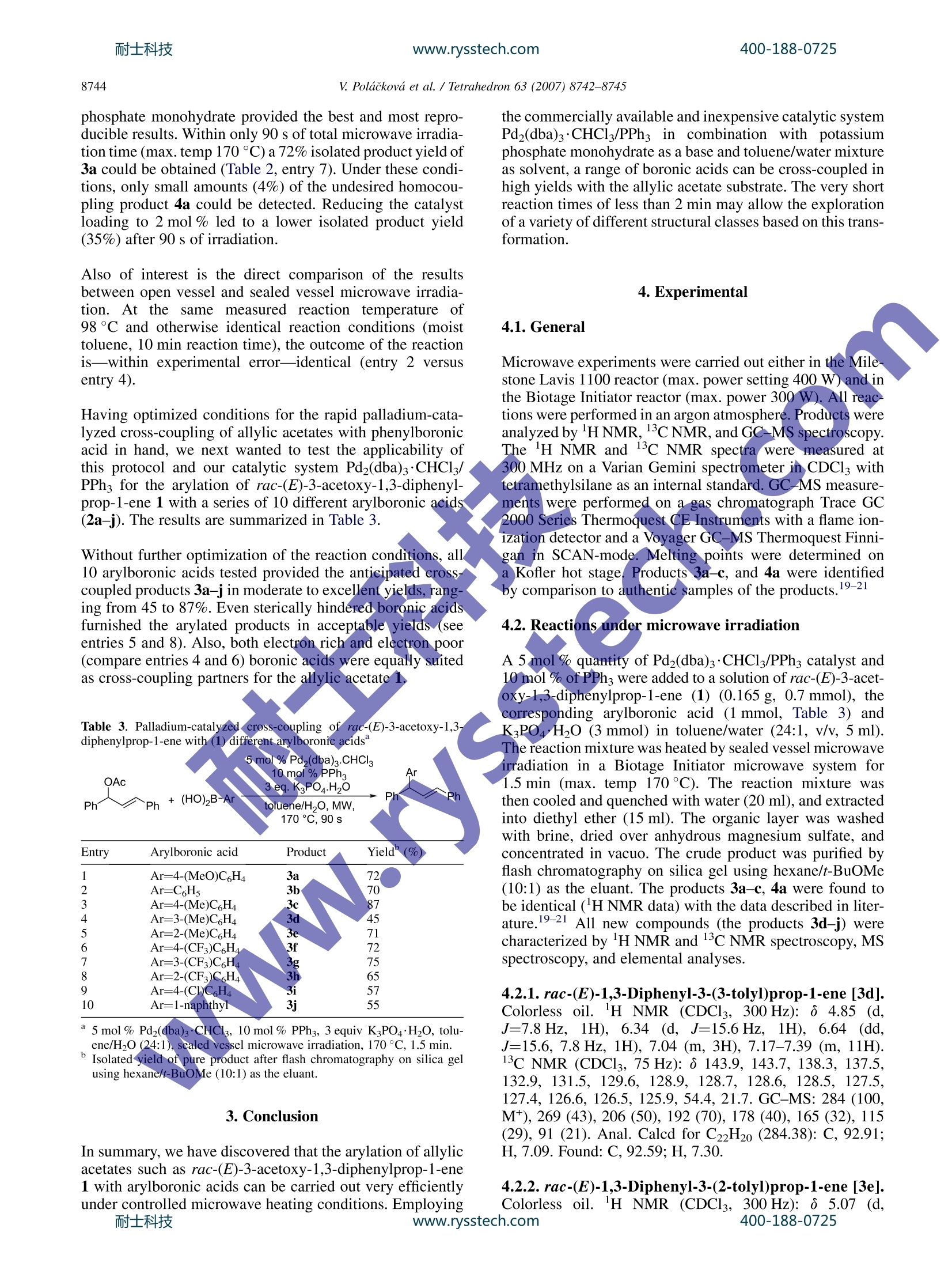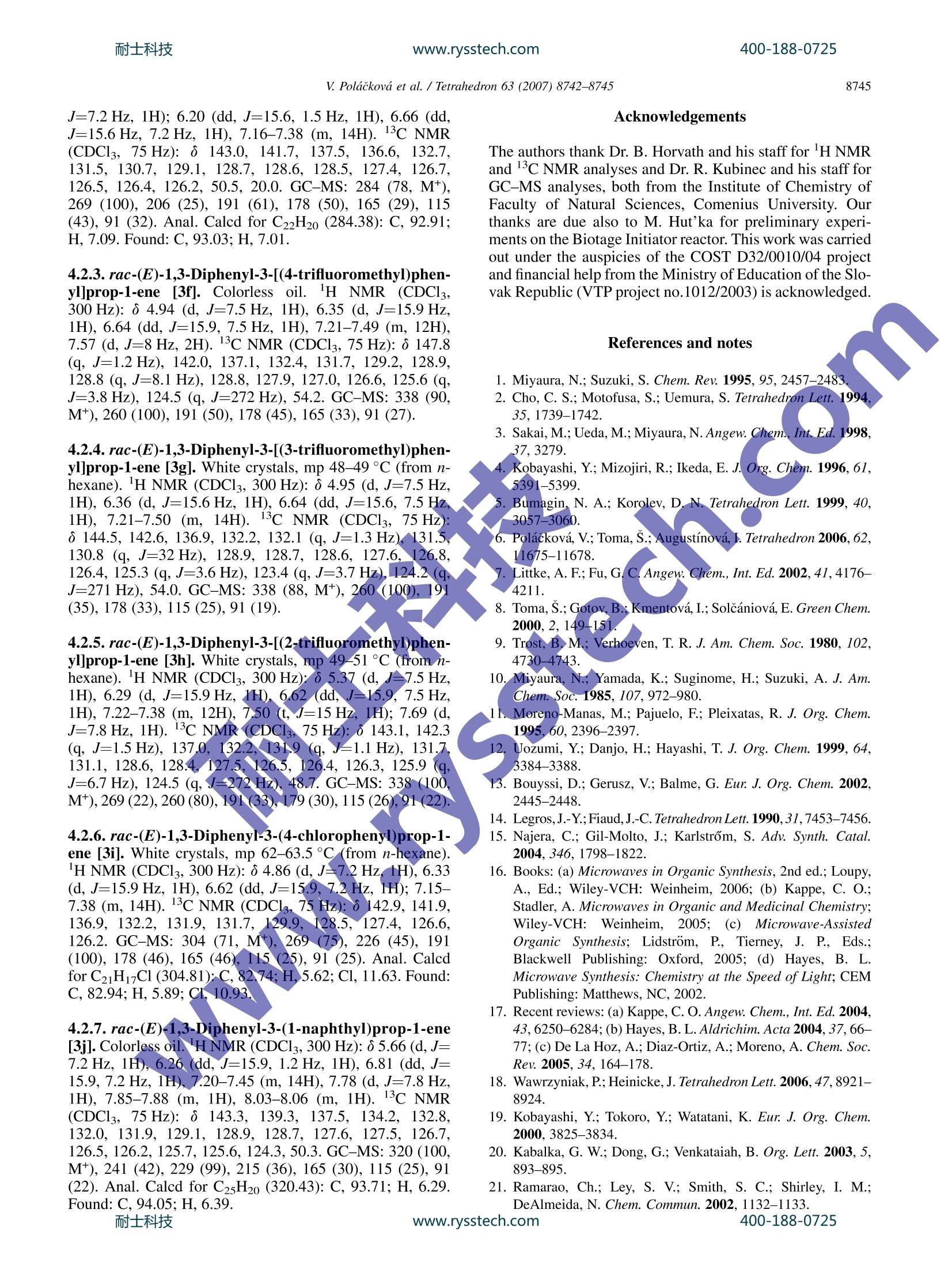
方案详情
文
The palladium-catalyzed arylation of rac-(E)-3-acetoxy-1,3-diphenylprop-1-ene with arylboronic acids was studied under controlled microwave irradiation conditions. Avariety of different catalysts, bases, and solvents were explored in order to achieve optimum yields in the shortest possible reaction times. The best isolated yields were obtained using Pd2(dba)3$CHCl3/PPh3 as the catalytic system, potassium phosphate monohydrate as the base, and toluene/H2O as a solvent system. Microwave irradiation using 5 mol% of the palladium catalyst for 90 s (max. temp 170 C) generally afforded the cross-coupling products in good to excellent yields.
方案详情

耐士科技400-188-0725www.rysstech.comAvailable online at www.sciencedirect.comScienceDirectTetrahedron 63 (2007)8742-8745 耐士科技400-188-0725www.rysstech.com8743 Tetrahedron Microwave-assisted arylation of rac-(E)-3-acetoxy-1,3-diphenylprop-1-ene with arylboronic acids Viera Polackova, Stefan Toma,* and C. Oliver Kappe Department of Organic Chemistry, Faculty of Natural Sciences, Comenius University, Mlynska dolina CH-2, SK-842 15 Bratislava, Slovak Republic Christian Doppler Laboratory for Microwave Chemistry (CDLMC) and Institute of Chemistry,Karl-Franzenes University, Heinrichstrasse 28, Graz, Austria Received 15 March 2007; revised 28 May 2007; accepted 14 June 2007Available online 21 June 2007 Abstract-The palladium-catalyzed arylation of rac-(E)-3-acetoxy-1,3-diphenylprop-1-ene with arylboronic acids was studied under con-trolled microwave irradiation conditions. A variety of different catalysts, bases, and solvents were explored in order to achieve optimum yieldsin the shortest possible reaction times. The best isolated yields were obtained using Pd2(dba)3·CHCl;/PPh, as the catalytic system, potassiumphosphate monohydrate as the base, and toluene/H2O as a solvent system. Microwave irradiation using 5 mol % of the palladium catalyst for90 s (max. temp 170°C) generally afforded the cross-coupling products in good to excellent yields. O 2007 Elsevier Ltd. All rights reserved. 1.Introduction Organoboron compounds are well known as versatile re-agents in organic synthesis.In this context, a significantnumber of transition metal-catalyzed carbon-carbon bondforming reactions employing arylboronic acids (Suzukicoupling, conjugate addition to enones, addition to aldehydes,allylic substitution,and the cross-coupling reactionwith alkenes or acid chlorides56 have been described andreviewed recently. In particular, the allylic substitution reaction is a powerfulu1method used to construct new carbon-carbon bonds. Excel-lent selectivities have been obtained using palladium cata-lysts in combination with a rangeof chiral ligands.Palladium(0) complexes have also been shown to catalyzea wide variety of synthetically useful substitutions of allylicsubstrates with carbon nucleophiles. Rather surprisingly,however, only a few reports on the use of boronic acids asnucleophiles in palladium-catalyzed allylic substitution re-actions have been published.10-15 For example, the couplingofarylboronic acids with allyl bromides in the presence ofa base in refluxing benzene has been reported.10,11 Alongsimilar lines, Hayashi et al.described the reaction of phen-ylboronic acid with allylic acetates under basic conditions in ( Keywords: Palladium; Allylic substitution; Allylation; Boronic acid; Cross-coupling; A rylation; Microwave irradiation. ) ( * C orresponding a uthor. Tel. : +421 7 6 0296208; f a x: + 421 7 60296690; e-mail : toma@ f ns.uniba.sk ) water at room temperature using a resin-supported palla-dium catalyst. More recently, Balme and co-workersachieved good results for the arylation of cinnamyl acetateswith phenylboronic acid in methanol using dichlorobis(tri-2-furylphosphane) as the catalyst and potassium fluoride as thebase. In related work, high conversions were achieved byNajera and co-workers in the aqueous cross-coupling ofphenylboronic acid with allylic acetates using PdCl2 com-plexes with amides of di-(2-pyridyl)methylamine as thecatalyst in the presence of a phase-transfer catalyst. We herewith report an experimentally very simple and fastprotocol for the palladium-catalyzed arylation of allylic ace-tates with a range of arylboronic acids. The new protocolmakes use of controlled microwave heating,uses a com-mercially available and inexpensive palladium source, andprovides good product yields in extremely short reactiontimes (90 s). 2. Results and discussion At the beginning of our work we decided to examine the ef-fect of the catalyst system (Pd source and base) on the courseof the allylic substitution reaction of rac-(E)-3-acetoxy-1,3-diphenylprop-1-ene 1 with 4-methoxyphenylboronic acid 2(Scheme 1, Table 1). The microwave-assisted arylation of rac-(E)-3-acetoxy-1,3-diphenylprop-1-ene (1) with 4-methoxyphenylboronic acid V. Polackovd et al. / Tetrahedron 63 (2007) 8742-8745 (2a) in toluene using Pd(PPh)3Cl2/PPh as the catalytic sys-tem and KPO4 as the base provided 52% of the desiredproduct 3a along with 35% of the homocoupling productof 4-methoxyphenylboronic acid, i.e., biphenyl 4a (entry1). Similar results were obtained when Pd(OAc)2/PPh wasused as the catalytic system. The product of arylation wasisolated in 58% yield and the homocoupling product was ob-tained in 18% yield (entry 2). The best yield(72%) of the de-sired arylation product 3a was obtained using Pd(PPh3)4/PPh as the catalyst. However, apart from the desired prod-uct 3a, 26% of the homocoupling product 4a were also iso-lated. Gratifyingly, a better selectivity was achieved usingthe Pd2(dba)3·CHCl3/PPh as catalyst system. Here, the isolated yield for the cross-coupling product 3a was 70%, whilethe homocoupling product 4a was isolated in only 4% yield(entry 4). Using Pd2(dba)3·CHCl in combination witho-(di-tert-butylphosphino)biphenyl (2-DTBPB)decreasedthe yield of cross-coupling product 3a to 21%((entry75). Table 1. Effect of the catalytic system (Pd/L=1:2) on the mierowave-assisted arylation of rac-(E)-3-acetoxy-1,3-diphenylprop-1-ene (1) with4-methoxyphenylboronic acid (2) in toluene Entry [Pd] source Ligand Base Yield of Yield of (3 equiv) 3a°(%) 4a (%) Pd(PPh3)2Cl2 PPh KPO Pd(OAc)2 PPh KPO4 Pd(PPh3)4 PPhs K3PO4 Pd2(dba)3·CHCl3 PPh3 K3PO4 Pd2(dba)3·CHCl: (2-DTBPB) K3PO4 Pd2(dba)3·CHCl3 (2-DTBPB) CsF Pd2(dba)3·CHCl3 PPhs CsF Multimode microwave irradiation (Milestone Lavis 1100 reactor),5 mol % of catalyst, 10 mol% of ligand, 1.42 equiy of boronic acid,h3i equiv of base, reaction time 10 min, max. temp 98Isolated yields of pure products after flash chromatography.2-DTBPB=o-(di-tert-butylphosphino)biphenyl The same catalytic system in combination with CsF as thebase gave similar low yields of the desired arylated product(entry 6). In addition, the use of Pd2(dba)3·CHCl3/PPh incombination with CsF yielded unacceptable low productyields (entry 7). Control experiments on the arylation of rac-(E)-3-acetoxy-1,3-diphenylprop-1-ene (1) with 4-methoxyphenylboronicacid (2a) performed by conventional heating (98°C, oilbath,10 min) mimicking the microwave conditions reportedin Table 1 (entry 4) provided significantly lower conversions.All the above mentioned microwave reactions were carriedout under open vessel conditions in a multimode microwaveMilestone Lavis 1100 reactor. Because of the low energydensity in a multimode system116,1and the fact that tolueneis a weak microwave absorber it was not possible to achievea higher reaction temperature than 98 °C within the selected10 min timeframe of the experiment. It was therefore of in-terest to see whether better results could be achieved ina closed vessel monomode system that allows superheatingthe reaction mixture to temperatures far above the boilingpoint of the solvent (110°C).16,17 Therefore, additional ex-periments were carried out in monomode reactor with sealedvessel capabilities (Table 2). Interestingly, we found that the conversions in the palla-dium-catalyzed arylation (Scheme 1) were dependent onthe quality of the potassium phosphate base, which is inaccord with recently published data by Wawrzyniak andHeinicke.18 In our hands, best results were typically withpotassium phosphate monohydrate as the base in combina-tion with toluene/H2O mixture as the solvent. Regulartoluene (technical grade), or toluene dried via azeotropicdistillation gave comparatively lower yields (Table2). Ulti-mately, the combination of a 24:1 toluene/water mixture and3 equiv of commercially available (Aldrich) potassium Table 2. Effect of temperature, base, and water on the arylation ofrac-(E)-3-acetoxy-1,3-diphenylprop-1-ene (1) with 4-methoxyphenylboronic acid (2)intoluene (Scheme 1)" Entry Toluene Base (3 equiv) MW conditions Max. temp (C) Time (min) Yield of 3a" (%) 1 Moist K3PO4 Open vessel 98 10 25 2 Moist K3PO4·nHO Open vessel 98 10 70 3 Dry K3PO4·nHO Sealed vessel 98 10 35 4 Moist K3PO4·nH2O Sealed vessel 98 10 65 5 Moist K3PO4·H2O Sealed vessel 130 10 47 6 Moist KPO4·H2O Sealed vessel 170 5 61 7 With H2O K3PO4·H2O Sealed vessel 170 1.5 72 Microwave irradiation, 5 mol % Pd2(dba)3·CHCl, as catalyst, 10 mol % of PPh as ligand, 1.42 equiv of boronic acid, 3 equiv of base. Moist: technical grade; dry: dried via azeotropic distillation; with water: toluene/water=24:1. ° Open vessel: Milestone Lavis 1100 multimode reactor (max. power: 400 W); sealed vessel: Biotage Initiator single mode reactor (max. power: 300 W).diIsolated yield of pure product after flash chromatography. phosphate monohydrate provided the best and most repro-ducible results. Within only 90 s of total microwave irradia-tion time (max. temp 170°℃) a 72% isolated product yield of3a could be obtained (Table 2, entry 7). Under these condi-tions, only small amounts (4%) of the undesired homocou-pling product 4a could be detected. Reducing the catalystloading to 2 mol % led to a lower isolated product yield(35%) after 90 s of irradiation. Also of interest is the direct comparison of the resultsbetween open vessel and sealed vessel microwave irradia-tion. At the same measured reaction temperature of98°C and otherwise identical reaction conditions (moisttoluene, 10 min reaction time), the outcome of the reactionis-within experimental error-identical (entry 2 versusentry 4). Having optimized conditions for the rapid palladium-cata-lyzed cross-coupling of allylic acetates with phenylboronicacid in hand, we next wanted to test the applicability ofthis protocol and our catalytic system Pd2(dba)3·CHCl3/PPh for the arylation of rac-(E)-3-acetoxy-1,3-diphenyl-prop-1-ene 1 with a series of 10 different arylboronic acids(2a-j). The results are summarized in Table 3. Without further optimization of the reaction conditions, all10 arylboronic acids tested provided the anticipated crosscoupled products 3a-j in moderate to excellent yields,rang-ing from 45 to 87%. Even sterically hindered boronic acidsfurnished the arylated products in acceptable yields (seeentries 5 and 8). Also, both electron rich and electron poor(compare entries 4 and 6) boronic acids were equally suitedas cross-coupling partners for the allylic acetate 11. Table 3. Palladium-catalyzed cross-coupling of rac-(E)-3-acetoxy-1,3-diphenylprop-1-ene with (1) different arylboronic acids" Entry Arylboronic acid Product Yield(%) Ar=4-(MeO)C6H4 Ar=C6H5 Ar=4-(Me)C,H4 Ar=3-(Me)C6H4 Ar=2-(Me)C,H4Ar=4-(CF3)C6H4 Ar=3-(CF3)C6H Ar=2-(CF3)C6H4 10 Ar=4-(C1)C,H4 Ar=1-naphthyl “ 5 mol% Pd2(dba)3CHCl3, 10 mol% PPh3, 3 equiv K3PO4·H2O, tolu-ene/H2O (24:1), sealed vessel microwave irradiation, 170 °C, 1.5 min. bIsolated yield of pure product after flash chromatography on silica gelusing hexane/t-BuOMe (10:1) as the eluant. 3. Conclusion In summary, we have discovered that the arylation of allylicacetates such as rac-(E)-3-acetoxy-1,3-diphenylprop-1-ene1 with arylboronic acids can be carried out very efficientlyunder controlled microwave heating conditions. Employing the commercially available and inexpensive catalytic systemPd2(dba)3·CHCl3/PPh3in combination withpotassiumphosphate monohydrate as a base and toluene/water mixtureas solvent, a range of boronic acids can be cross-coupled inhigh yields with the allylic acetate substrate. The very shortreaction times of less than 2 min may allow the explorationofa variety of different structural classes based on this trans-formation. 4. Experimental 4.1. General Microwave experiments were carried out either in the Mile-stone Lavis 1100 reactor (max. power setting 400 W) and inthe Biotage Initiator reactor (max. power 300 W). All reac-tions were performed in an argon atmosphere. Products wereanalyzed by 'HNMR,13CNMR, and GC-MS spectroscopy.The H NMR and 13c NMR spectra were measured at300 MHz on a Varian Gemini spectrometer in CDCls withtetramethylsilane as an internal standard. GC-MS measure-ments were performed on a gas chromatograph Trace GC2000 Series Thermoguest CE Instruments with a flame ion-ization detector and a Voyager GC-MS Thermoquest Finni-gan in SCAN-mode. Melting points were determined ona KFofler hot stage. Products 3a-c, and 4a were identifiedby comparison to authentic samples of the products.19-21 4.2. Reactions under microwave irradiation A 5 mol % quantity of Pd2(dba)3·CHCl3/PPh3 catalyst and10 mol % of PPhs were added to a solution of rac-(E)-3-acet-oxy-1,3-diphenylprop-1-ene (1) (0.165 g, 0.7 mmol), thecorresponding arylboronic acid (1 mmol, Table 3) andK3PO4HO (3 mmol) in toluene/water (24:1, v/v, 5 ml).The reaction mixture was heated by sealed vessel microwaveirradiation in a Biotage Initiator microwave system for1.5 min (max. temp 170°C). The reaction mixture wasthen cooled and quenched with water (20 ml), and extractedinto diethyl ether (15 ml). The organic layer was washedwith brine, dried over anhydrous magnesium sulfate, andconcentrated in vacuo. The crude product was purified byflash chromatography on silica gel using hexane/t-BuOMe(10:1) as the eluant. The products 3a-c, 4a were found tobe identical (HNMR data) with the data described in liter-ature.19-21 All new compounds (the products 3d-j) werecharacterized by 'HNMR and 13c NMR spectroscopy, MSspectroscopy, and elemental analyses. 4.2.1. rac-(E)-1,3-Diphenyl-3-(3-tolyl)prop-1-ene [3d].Colorless oil. H NMR (CDCl3, 300 Hz): 4.85 (d,J=7.8 Hz, 1H), 6.34 (d, J=15.6 Hz, 1H), 6.64 (dd,J=15.6,7.8 Hz, 1H), 7.04 (m, 3H), 7.17-7.39 (m, 11H).C NMR (CDCl3, 75 Hz):6 143.9,143.7,138.3,137.5,132.9,131.5,129.6,128.9,128.7,128.6,128.5,127.5,127.4,126.6,126.5,125.9,54.4, 21.7. GC-MS: 284 (100,M*), 269 (43), 206 (50), 192(70),178(40),165 (32), 115(29), 91 (21). Anal. Calcd for C22H20 (284.38): C, 92.91;H, 7.09. Found: C, 92.59; H, 7.30. 4.2.2. rac-(E)-1,3-Diphenyl-3-(2-tolyl)prop-1-ene [3e].Colorless oil. 'H NMR (CDCl3, 300 Hz): 8 5.07(d,400-188-0725 J=7.2 Hz, 1H); 6.20 (dd, J=15.6, 1.5 Hz, 1H), 6.66 (dd,J=15.6 Hz, 7.2 Hz, 1H), 7.16-7.38 (m, 14H). 13C NMR(CDCl3, 75 Hz): ;143.0,141.7,137.5,136.6,132.7,131.5,130.7,129.1,128.7,128.6,128.5,127.4,126.7,126.5,126.4,126.2,50.5, 20.0. GC-MS: 284 (78,Mt),269 (100),206(25),191(61),178(50),165(29), 115(43), 91 (32). Anal. Calcd for C22H20(284.38): C, 92.91;H, 7.09. Found: C, 93.03; H, 7.01. 4.2.3. rac-(E)-1,3-Diphenyl-3-[(4-trifluoromethyl)phen-yl]prop-1-enee[3f]. Colorlessoil.H NMR (CDCl3,300 Hz): ; 4.94 (d, J=7.5 Hz, 1H), 6.35 (d, J=15.9 Hz,1H), 6.64 (dd,J=15.9, 7.5 Hz, 1H), 7.21-7.49 (m, 12H),7.57 (d, J=8 Hz, 2H). 13C NMR (CDCl3, 75 Hz): ; 147.8(q, J=1.2Hz), 142.0,137.1,132.4,131.7,129.2,128.9,128.8 (q, J=8.1 Hz), 128.8,127.9,127.0,126.6,125.6(q,J=3.8 Hz), 124.5 (q, J=272 Hz), 54.2. GC-MS: 338 (90,M*),260(100),191 (50),178(45),165(33),91 (27). 4.2.4.rac-(E)-1,3-Diphenyl-3-[(3-trifluoromethyl)phen-ylprop-1-ene [3g]. White crystals, mp 48-49C (from n-hexane). H NMR (CDCl3, 300 Hz): 4.95 (d, J=7.5 Hz,1H), 6.36 (d, J=15.6 Hz, 1H), 6.64 (dd, J=15.6, 7.5 Hz,1H), 7.21-7.50 (m, 14H). 13C NMR (CDCl3, 75 Hz):o 144.5, 142.6,136.9, 132.2, 132.1 (q, J=1.3 Hz), 131.5,130.8 (q, J=32 Hz), 128.9, 128.7,128.6,127.6,126.8,126.4, 125.3 (q, J=3.6 Hz), 123.4 (q,J=3.7 Hz),124.2(qJ=271 Hz), 54.0. GC-MS: 338 (88, M*), 260(100),,1991(35),178(33),115(25),91(19). 4.2.5.rac-(E)-1,3-Diphenyl-3-[(2-trifluoromethyl)phen-yl]prop-1-ene [3h]. White crystals, mp 49-51°C (from n-hexane). H NMR (CDCl3, 300 Hz): 6 5.37 (d, J-7.5 Hz,1H), 6.29 (d,J=15.9 Hz, 1H), 6.62 (dd,,J=15.9,7.5 Hz,1H),7.22-7.38(m, 12H), 7.5006(t,J=15Hz, 1H);7.69 (d,J=7.8 Hz, 1H). 13C NMR (CDCl75 Hz): 8 143.1,142.3(q,J=1.5 Hz), 137.0, 132.2,131.99(q, J=1.1Hz), 131.7,131.1, 128.6,128.4,.127.5. 126.5,126.4,126.3,125.9 (q,J=6.7 Hz), 124.5 (q, J=272HHzz)),, 48.7. GC-MS: 338 (100,M*), 269(22),260(80),191(33),179(30),115(26),91(22). 4.2.6. rac-(E)-1,3-Diphenyl-3-(4-chlorophenyl)prop-1-ene [3i]. White crystals, mp 62-63.5°℃ (from n-hexane).HNMR (CDCl3, 300 Hz): ; 4.86 (d,J=7.2Hz, 1H)7?1, 6.33(d, J=15.9 Hz, 1H), 6.62 (dd, J=15.9, 7.2 Hz, 1H); 7.15-7.38 (m, 14H). 13C NMR (CDCL3,75 Hz): 6 142.9, 141.9,136.9,132.2,131.9,131.7,129.9,128.5,127.4,126.6,126.2. GC-MS: 304 (71,M)), 2669 (75),226 (45), 191(100),178 (46), 165 (46), 1155(25), 91 (25). Anal. Calcdfor C2jH17Cl (304.81): C, 82.74; H, 5.62; Cl, 11.63.Found:C, 82.94; H, 5.89;CI, 10.93. ( 4.2.7. rac-(E ) -1, 3 -Diphenyl-3-(1-naphthyl)prop-1-ene [3j]. Color l ess oi l.HNMR (CDCl3,300 Hz): 8 5.66 (d,J= 7.2 Hz, 1H) , 6.2 6 (dd, J =15.9, 1 .2Hz, 1H), 6.81 ( dd, J=15.9, 7.2 Hz, 1H) , 7 . 20-7.45( m , 14H), 7.78 (d, J = 7.8 Hz , 1H), 7.85-7.88 (m, 1H), 8.03-8.0 6 (m , 1H) . 13C NMR (CDCl3, 75 Hz):8) ] 1 43.3, 1 39.3,137.5,134.2, 132.8,132.0, 131.9,129.1,128.9 , 128.7,127.6,127.5, 1 26.7, 126.5,126.2,125.7,125.6,124.3,50.3. GC-MS: 320 (100,M*), 241 (42), 229 (99),21 5 (36) , 165 ( 30), 1 15(25),91(22). Anal. Calcd f or C25H20 ( 320.43): C, 93.71; H , 6.29. ) Found: C, 94.05; H, 6.39. The authors thank Dr. B. Horvath and his staff for H NMRand 1C NMR analyses and Dr. R. Kubinec and his staff forGC-MS analyses, both from the Institute of Chemistry ofFaculty of Natural Sciences, Comenius University. Ourthanks are due also to M. Hut’ka for preliminary experi-ments on the Biotage Initiator reactor. This work was carriedout under the auspicies of the COST D32/0010/04 projectand financial help from the Ministry of Education of the Slo-vak Republic (VTP project no.1012/2003) is acknowledged. ( References and notes ) ( 1. Miyaura,N.; Suzuki, S. C hem. Rev. 1995, 95, 2 457-24 8 3 ) ( 2. Cho, C. S.; Motofusa, S.; Uemura, S. T etrahedro n Lett. 1994, 35, 1 739-1742. ) ( 3. Sakai,M.; Ueda,M.;Miyaura, N. Angew. Ch e m . , I nt . Ed . 1998, 37,3279. ) ( K obayashi, Y.; Mizojiri, R.; Ikeda, E. J. O rg . C hem. 1996,61, 5 391-5399. ) ( Bumag i n, N . A . ; K o rolev, D . N . T e trahedron Lett. 1 9 99, 40, 30 57- 3 060. ) ( 6. P o l ac k ova,V.; Toma, S.; A u g ustinova, I. Tetrahedron 2006, 62, 116 7 5-11678. ) ( Littk e , A. F.; Fu, G . C . Angew . C h em., Int. Ed.2002,41,4176-'42 1 1 . ) ( 8. Toma,S.; Got o v, B .; K mentova, I.; Solcaniova, E. Green Chem. 2000,2,149-1 5 1 ) ( 9. Trost, B. M.; V erho e v e n, T. R. J. A m. Chem. So c . 19 8 0, 10 2 ,4730-47 4 3. ) ( 10 . . Miyaura,N. ; Yamada, K .; S uginome, H.; Suzuki, A. J. A m . C he m. S oc. 1985, 107,972-980. ) ( 1 1. Mor e n o -Manas, M . ; Pajuelo, F; Pleixatas, R. J. Org. Chem.1995, 60,2396-2397. ) ( 12 U o zumi, Y.;D a njo, H.; H a yashi, T . J . Org. Chem. 1999, 64, 3 384-3388. ) ( 1 3 . Bouyssi, D.; Gerusz, V.; Balme, G. Eur: J. Org. Chem. 2002, 2445-2448. ) ( 1 4. L egros,J.-Y.;Fiaud,J.-C. Tetrahedron Lett. 1990,31,7453-7456. ) ( 1 5. N ajera, C .; G il-Molto, J . ; Karlstrom, S . Adv. Sy n th. Ca t al.2004,346, 1 798-1822. ) ( 16. Books: ( a) Microwaves in Organic Synthesis, 2nd e d.; Loupy,A., Ed.; Wiley-VCH: W einheim, 2 0 06; (b) K a ppe, C. O.; Stadler, A. Microwaves in O rganic and Medicinal Chemistry;Wiley-VCH: W einheim, 2 005; ( c) Microwave-Assisted Organic Synthesis; Lidstrom, P., T ierney, J. P., Eds.; Blackwell P ublishing : Oxford, 2005; (d) H ayes, B. L. Microwave Synthesis: Chemistry at the Speed of Light; CEM Publishing: Matthews, NC, 2002. ) ( 17. Recent reviews:(a) Kappe, C. O. Angew. Chem., I nt. Ed.2004,43, 6250-6284;(b) Hayes,B. L. Aldrichim. Acta 2004, 37, 66-77;(c) D e La Hoz, A.; Diaz-Ortiz, A.; Moreno, A. Chem. Soc.Rev. 2 005, 34, 164-178. ) ( 18. Wawrzyniak, P. ; Heinicke, J. Tetrahedron Lett. 2006,47,8921- 8924. ) ( 19. Kobayashi, Y.; T okoro, Y.; Watatani, K. E u r. J . O r g. C h em. 2000, 3 825-3834. ) ( 20. Kabalka, G.W.; Dong, G.; Venkataiah, B. Org. Lett. 20 0 3, 5, 893-895. ) ( 21. Ramarao, Ch.; L ey, S. V.; Smith, S . C.; S hirley, I. M.; DeAlmeida, N. Chem. Commun. 2002, 1132-1133. ) doi:j.tet.ww.rysstech.com耐士科技 耐士科技
确定




还剩2页未读,是否继续阅读?
上海鑫欣生物科技有限公司为您提供《化学药中特殊物质和基团检测方案 》,该方案主要用于化药新药研发中其他检测,参考标准--,《化学药中特殊物质和基团检测方案 》用到的仪器有
相关方案
更多
该厂商其他方案
更多








